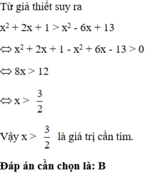

Hãy nhập câu hỏi của bạn vào đây, nếu là tài khoản VIP, bạn sẽ được ưu tiên trả lời.



\(x^2+y^2-xy-2x-2y+9=x^2+y^2+2xy-2x-2y+9-3xy\)
\(=\left(x+y\right)^2-2\left(x+y\right)+9-3xy=\left(x+y-2\right)\left(x+y\right)+9-3xy.\)
\(đếnđâytịt\)
b
c, =3 dễ
\(\frac{3x^2-6x+9}{x^2-2x+3}=\frac{3\left(x^2-2x+3\right)}{x^2-2x+3}=3\)

Bạn nhân biểu thức lên 2 lần (mình đặt là A nên nhân 2 lần là 2A)
Nhóm theo hằng đảng thức ta được (x-y)^2 +(x-2)^2 +(y-2)^2 +10
Bạn chứng minh nó luôn lớn hơn hoặc bằng 10 với mọi x,y vì mỗi bình phương luôn lớn hơn 0 và công 10 nên lớn hơn hoặc bằng 10 => 2A>=10 => A>= 5
Dấu bằng xảy ra khi và chỉ khi x=y=2

bài1 A=\(\left(\frac{3-x}{x+3}\cdot\frac{x^2+6x+9}{x^2-9}+\frac{x}{x+3}\right):\frac{3x^2}{x+3}\)
=\(\left(-\frac{x-3\cdot\left(x+3\right)^2}{\left(x+3\right)^2\cdot\left(x-3\right)}+\frac{x}{x+3}\right):\frac{3x^2}{x+3}\)
=\(-\frac{x}{x+3}\cdot\frac{x+3}{3x^2}=\frac{-1}{3x}\)
b) thế \(x=-\frac{1}{2}\)vào biểu thức A
\(-\frac{1}{3\cdot\left(-\frac{1}{2}\right)}=\frac{2}{3}\)
c) A=\(-\frac{1}{3x}< 0\)
VÌ (-1) <0 nên 3x>0
x >0

a, Vì \(2+\frac{3-2x}{5}\)không nhỏ hơn \(\frac{x+3}{4}-x\)
\(\Rightarrow2+\frac{3-2x}{5}\ge\frac{x+3}{4}-x\)
Giải phương trình :
\(2+\frac{3-2x}{5}\ge\frac{x+3}{4}-x\)
\(\Rightarrow\frac{40}{20}+\frac{4\left(3-2x\right)}{20}\ge\frac{5\left(x-3\right)}{20}-\frac{20x}{20}\)
\(\Rightarrow40+12-8x\ge5x-15-20x\)
\(\Rightarrow7x=67\)
\(\Rightarrow x\ge\frac{67}{7}\)
b, \(\frac{2x+1}{6}-\frac{x-2}{9}>-3\)
\(\Rightarrow\frac{3\left(2x+1\right)}{18}-\frac{2\left(x-2\right)}{18}>\frac{-54}{18}\)
\(\Rightarrow6x+3-2x+4>-54\)
\(\Rightarrow4x>-61\)
\(\Rightarrow x>\frac{-61}{4}\)\(\left(1\right)\)
Và : \(x-\frac{x-3}{4}\ge3-\frac{x-3}{12}\)
\(\frac{12x}{12}-\frac{3\left(x-3\right)}{12}\ge\frac{36}{12}-\frac{x-3}{12}\)
\(\Rightarrow12x-3x+9\ge36-x+3\)
\(\Rightarrow10x\ge30\)
\(\Rightarrow x\ge3\)\(\left(2\right)\)
Từ \(\left(1\right)\)và \(\left(2\right)\)\(\Rightarrow\hept{\begin{cases}x>\frac{-61}{4}\\x\ge3\end{cases}\Rightarrow x>3}\)
Vậy với giá trị x > 3 thì x là nghiệm chung của cả 2 bất phương trình

\(A=\left(a+2b-5+b\right)^2-2ab+34=\left(a+2b-5\right)^2+2b\left(a+2b-5\right)+b^2-2ab+34\)
\(A=\left(a+2b-5\right)^2+5b^2-10b+5+29\)
\(A=\left(a+2b-5\right)^2+5\left(b-1\right)^2+29\ge29\)
\(A_{min}=29\) khi \(\hept{\begin{cases}a=3\\b=1\end{cases}}\)
\(B=x+\frac{25}{x}-8\ge2\sqrt{x.\frac{25}{x}}-8=2\)
\(B_{min}=2\) khi \(x=5\)
\(C=\frac{x^2-15x+36}{x}=x+\frac{36}{x}-15\ge2\sqrt{x.\frac{36}{x}}-15=-3\)
\(C_{min}=-3\) khi \(x=6\)

1. ( 2x + y )( 4x2 - 2xy + y2 ) - 8x3 - y3 - 16
= [ ( 2x )3 + y3 ] - 8x3 - y3 - 16
= 8x3 + y3 - 8x3 - y3 - 16
= -16 ( đpcm )
2. ( 3x + 2y )2 + ( 3x + 2y )2 - 18x2 - 8y2 + 3
= 2( 3x + 2y )2 - 18x2 - 8y2 + 3
= 2( 9x2 + 12xy + 4y2 ) - 18x2 - 8y2 + 3
= 18x2 + 24xy + 8y2 - 18x2 - 8y2 + 3
= 24xy + 3 ( có phụ thuộc vào biến )
3. ( -x - 3 )3 + ( x + 9 )( x2 + 27 ) + 19
= -x3 - 9x2 - 27x - 27 + x3 + 9x2 + 27x + 243 + 19
= -27 + 243 + 19 = 235 ( đpcm )
4. ( x - 2 )3 - x( x + 1 )( x - 1 ) + 13( x - 4 )
= x3 - 6x2 + 12x - 8 - x( x2 - 1 ) + 13x - 52
= x3 - 6x2 + 12x - 8 - x3 + x + 13x - 52
= -6x2 + 26x - 60 ( có phụ thuộc vào biến )

a) A có nghĩa khi \(\hept{2x-2\ne02-2x^2\ne0\Leftrightarrow\hept{\begin{cases}2x\ne2\\2x^2\ne2\end{cases}\Leftrightarrow}\hept{\begin{cases}x\ne1\\x\ne\pm1\end{cases}\Leftrightarrow}x\ne\pm1}\)
Vậy A có nghĩa khi \(x\ne\pm1\)
b) \(A=\frac{x}{2x-2}+\frac{x^2+1}{2-2x^2}\left(x\ne\pm1\right)\)
\(\Leftrightarrow A=\frac{x}{2\left(x-1\right)}+\frac{x^2+1}{2\left(1-x^2\right)}\)
\(\Leftrightarrow\frac{x}{2\left(x-1\right)}-\frac{x^2+1}{2\left(x-1\right)\left(x+1\right)}\)
\(\Leftrightarrow A=\frac{x\left(x+1\right)}{2\left(x-1\right)\left(x+1\right)}-\frac{x^2+1}{2\left(x-1\right)\left(x+1\right)}\)
\(\Leftrightarrow A=\frac{x^2+x-x^2+1}{2\left(x-1\right)\left(x+1\right)}=\frac{x+1}{2\left(x-1\right)\left(x+1\right)}=\frac{1}{2\left(x-1\right)}\)
Vậy A=\(\frac{1}{2\left(x-1\right)}\left(x\ne\pm1\right)\)
b) \(A=\frac{1}{2\left(x-1\right)}\left(x\ne\pm1\right)\)
A=\(\frac{-1}{2}\)\(\Leftrightarrow\frac{1}{2\left(x-1\right)}=\frac{-1}{2}\)
\(\Leftrightarrow-2\left(x-1\right)=2\)
<=> x-1=-1
<=> x=0 (tmđk)
Vậy x=0 thì \(A=\frac{-1}{2}\)

a) B xác định\(\Leftrightarrow\hept{\begin{cases}x+1\ne0\\x-1\ne0\end{cases}}\Rightarrow x\ne\pm1\)
b) \(x^2-x=0\Leftrightarrow x\left(x-1\right)=0\)
\(\Leftrightarrow\orbr{\begin{cases}x=0\\x-1=0\end{cases}}\Leftrightarrow\orbr{\begin{cases}x=0\\x=1\end{cases}}\)
Mà x khác 1 nên x = 0
\(B=\frac{x-1}{x+1}-\frac{x+1}{x-1}-\frac{4}{1-x^2}\)
\(=\frac{\left(x-1\right)^2-\left(x+1\right)^2}{\left(x+1\right)\left(x-1\right)}+\frac{4}{x^2-1}\)
\(=\frac{x^2-2x+1-x^2-2x-1}{\left(x+1\right)\left(x-1\right)}+\frac{4}{x^2-1}\)
\(=\frac{-4x}{\left(x+1\right)\left(x-1\right)}+\frac{4}{\left(x+1\right)\left(x-1\right)}\)
\(=\frac{-4x+4}{\left(x+1\right)\left(x-1\right)}=\frac{-4\left(x-1\right)}{\left(x+1\right)\left(x-1\right)}=\frac{-4}{x+1}\)
Thay x = 0 vào B, ta được \(P=\frac{-4}{0+1}=-4\)
Vậy P = -4 khi \(x^2-x=0\)
c) \(B=-3\Leftrightarrow\frac{-4}{x+1}=-3\Leftrightarrow x+1=\frac{4}{3}\)
\(\Leftrightarrow x=\frac{1}{3}\)
Vậy B = -3 khi \(x=\frac{1}{3}\)
d) \(B< 0\Leftrightarrow\frac{-4}{x+1}< 0\Leftrightarrow x+1>0\Leftrightarrow x>-1\)
Vậy x > - 1 thì B < 0
tích cho cậu là ấn vào link hay là thích